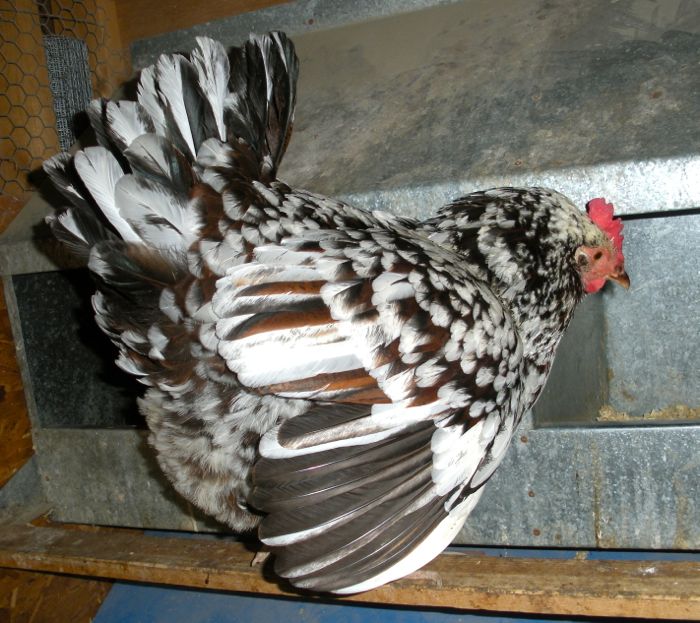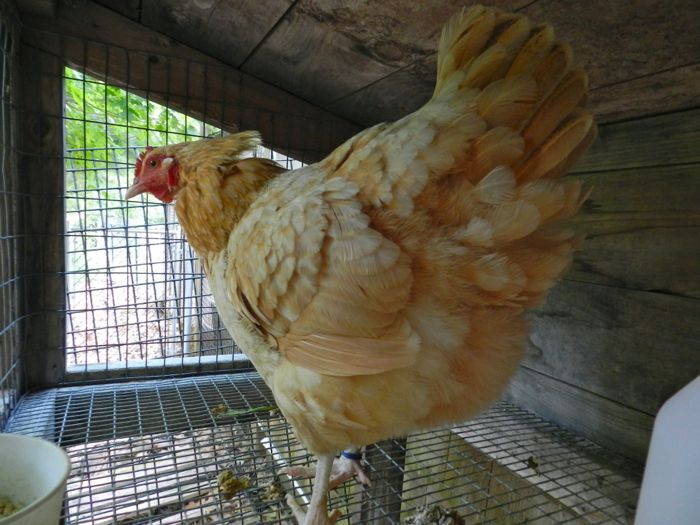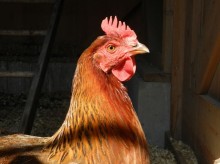A hen goes about her day, sleeping, eating, dust bathing, scratching the ground, and generally doing chicken things. She’ll lay an egg daily, or at least several times a week. She’ll take a break to molt in the fall, and won’t lay again until the darkest days of winter are over, but, generally, she’s active and productive. So, one day in the summer, when you step into the coop and your chicken is flattened like a platter in the nesting box, and she makes a horrid rasping noise, you worry. You pick her up and set her down on the ground and she remains fluffed out to three times her size and doesn’t move. The other hens either avoid her or rush up and peck her comb. She hurries back into the nest and yells at you. She does this day after day. She pulls the feathers out of her breast. You worry that she’s not eating. She’s certainly not laying.
She’s not ill. You have a broody hen.
A broody hen is one who thinks that she is incubating eggs to hatch. It doesn’t matter that there’s nothing under her, although sometimes there is. She’ll sit on eggs that the others have laid. Sometimes a broody will kick a hen out of a nesting box and in her deranged state smash the very eggs that she’s claiming. Sometimes a broody will even sit on top of a hen that is laying. Incubation is three weeks and a broody hen might stay in a box for that entire time. Or longer. Some hens are genetically programmed to go broody. Some never do. There are breeds more prone to broodiness, such as the Cochins, Silkies and Buff Orpingtons.
You might not see her do it, but once a day a broody hen will get up and out of the nesting box, leave a ginormous stinky pile of poo, and eat and drink. She might even take a dust bath. Then she’ll go back on her nest. She’ll sit there, even on dangerously hot days when everyone else is staying cool in the shade. She won’t starve, but she will lose condition. You’ll want to do something.
If you’ve always wanted to hatch chicks, then this is your chance to do it without an incubator or a brooder. She’ll do the job. Just remember that at least half of the chicks will be boys, and you’ll need a plan about what to do with them. If this broodiness happens to coincide with an arrival of an order of day-old chicks, you can pop them under her at night and when she wakes up in the morning, she’ll be tremendously proud of herself. (Actually, there’s more to it that this – the broody that is going to care for chicks should be in separate housing.) However, this post isn’t about raising chicks. It’s about what to do about that angry, useless hen that is now taking up space in your coop and annoying anyone within a hundred yards of her.
You can ignore her. At some point she’ll stop being broody. That’s what I do with Pearl, the most perfect broody hen in the world. Pearl is a cochin. She spends the majority of her time filling up a nesting box. But she also gets up and out several times a day, especially if she hears that there are yummy things in the compost pile. She dust bathes. She takes a half-hour to free-range with the other girls. She doesn’t threaten any of them. She’s not laying, but she’s so content and true to herself that I let her be.
Unfortunately, most broodies aren’t perfect like Pearl. Instead, they’re horrors, like Topaz. Topaz is a Buff Orpington. When she goes broody she becomes henzilla – the angriest hen on the planet. She smashes eggs. She growls at hens and people alike. Lulu, a Speckled Sussex, was equally bonkers when broody.
To break the spell, I put the broody hen into the anti-broody coop, which was originally an old rabbit hutch.
I supply the hen with food and water. There’s no place to nest and nothing to do. The wire floor allows for air circulation under her. This is essential, as broodiness is tied into an elevated body temp, and bringing it down will help to break the broody cycle. Some people claim that you can do this quickly by giving the hen a soak in cold water. I hosed down Topaz’s butt. It did nothing but make her wet and angrier. Some people say that you can slip a cold pack (or package of frozen peas) under her in the nesting box to chill her off. I did this and Topaz was delighted to have something to brood and it did nothing to break the spell. What does work is three days in the anti-broody coop. You’ll know your hen is back to normal when she greets you with normal clucks and is back to having her feathers at her side.
Some hens are persistently broody. After time in the anti-broody coop, Topaz will return to normal and lay eggs, and then a few weeks down the road will go broody again. She is a serial broody. Some will go broody only once and that will be it for the season. If your broody hen lives into old age, at some point she’ll stop going broody. Twinkydink was six the first year that she didn’t hunker down in a nesting box. In her seventh year she started laying eggs again (sporadically, but still, she laid!) So, you never know.





